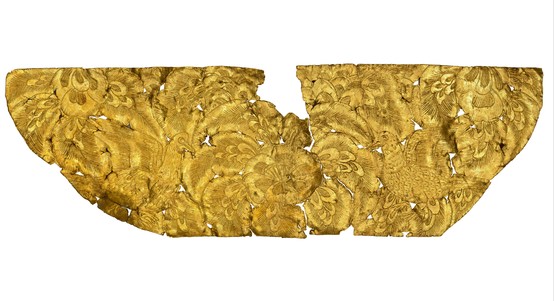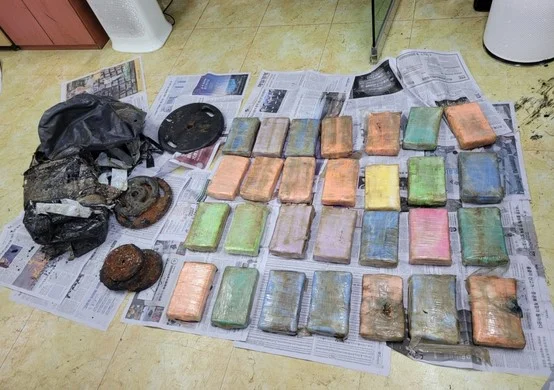영자신문읽기[고급] 신문 속 다양한 세상 이야기를 이제 영어로 만나보세요!
Thin gold with mysteriously fine engravings is excavated
2022-06-22

A pure gold artifact with almost microscopic carving was discovered in an excavation of the Donggung Palace and Wolji Pond, a royal site during the Unified Silla period (668-935) in North Gyeongsang.
The Gyeongju National Research Institute of Cultural Heritage showed the delicate piece to the press on Thursday and said it will be exhibited publicly from June 17 to Oct. 31 at the Gyeongju National Research Institute of Cultural Heritage.
It was surprising enough that this 3.6 by 1.17 centimeters (0.11 by 0.038 foot) artifact was discovered in a vast 18,100 square-meter excavation site. Then the experts found this paper-thin piece of gold was used as a canvas to engrave two birds and imaginary flowers called danhwa. The birds were carved at a thickness of 0.05 millimeters, which is finer than human hair.
According to the Gyeongju National Research Institute of Cultural Heritage, the artifact was initially discovered in two pieces about 20 meters from each other, in November 2016. They were crumpled and mixed with mud.
“We were not aware of the engraved patterns on the two pieces for a while,” said Kim Gyeong-yeol, a researcher from the Gyeongju National Research Institute of Cultural Heritage. After washing the dirt off the crumpled leaves, “which were the size of a small adzuki bean, we noticed the engravings. We could see the exact design after putting them under the microscope.”
Shim Myeong-bo, a preservation expert at the institute said it took him “six whole months to carefully unfold the artifact using tweezers.” The hardest part was “making sure that no scratches were made during the process as the gold is so delicate and thin.”
The institute explained that it could not reveal the find to the public until it had studied the artifact, trying to understand what it was used for, how the engraving was done and what kind of tools were used by the artisan.
It took them more than five years and many questions are still unanswered as there’s “no other thing like this.”
“We presume it dates back to the 8th century, during Korea’s Unified Silla period, and that it was engraved using a very sharp iron pin, which has to be thinner than any needles today,” said Kim.
“We determined that this trapezoid shape had been cut out from a larger piece of gold leaf after the pattern was engraved, and that the gold leaf must have been fixed to something such as a wooden support. Because there are no holes that were used to suspend the gold leaf, it is presumed that it was directly adhered to some kind of object. Although there are currently no examples to helps us determine how the gold leaf was used and its function, the shape of the artifact suggests that it was the end piece of an unknown object. We believe its intricate design, which is difficult to view with a naked eye, transcends purely decorative elements and may have potentially functioned as a dedication to gods.”
One thing that’s certain, according to the institute, is that metal craftsmen tried creating a replica during the research, but found it impossible to do, even with the help of a microscope.
“Only a highly-skilled craftsman could engrave such elegant patterns that cannot be seen with a naked eye,” said Kim. “It’s indeed the finest example of metalworking among all artifacts discovered in Korea and provides a glimpse into the artistry of Unified Silla as well as the elegant metal craftsmanship of the time.”

| 번호 | 기사목록 | 날짜 | 조회수 |
|---|---|---|---|
| 60 |
 |
2024-04-20 | 1577 |
| 59 |
 |
2024-04-19 | 4456 |
| 58 |
 |
2024-04-18 | 4362 |
| 57 |
 |
2024-04-17 | 4299 |
| 56 |
 |
2024-04-16 | 4205 |
| 55 |
 |
2024-04-15 | 4017 |
| 54 |
 |
2024-04-14 | 3827 |
| 53 |
 |
2024-04-13 | 3606 |



















